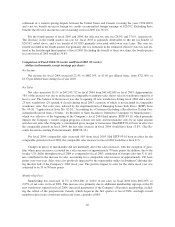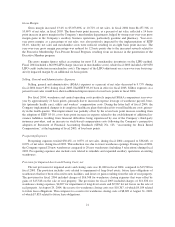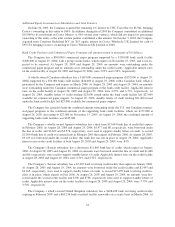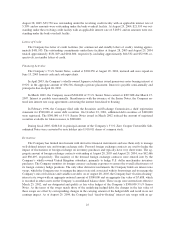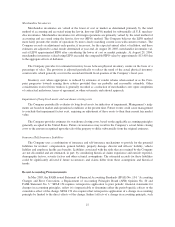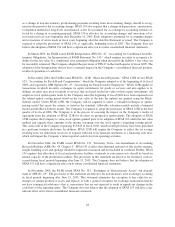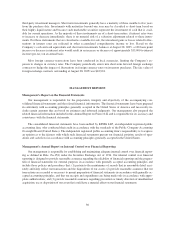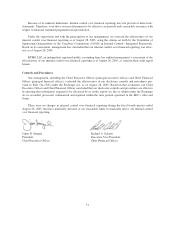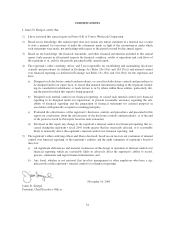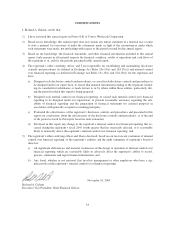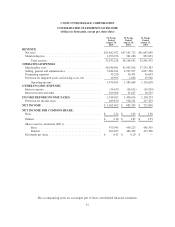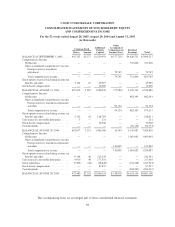Costco 2005 Annual Report Download - page 30
Download and view the complete annual report
Please find page 30 of the 2005 Costco annual report below. You can navigate through the pages in the report by either clicking on the pages listed below, or by using the keyword search tool below to find specific information within the annual report.In March 2004, the FASB EITF reached a consensus on EITF Issue No. 03-1, “The Meaning of Other-Than-
Temporary Impairment and Its Application to Certain Investments,” (EITF 03-1). The guidance prescribes a three-
step model for determining whether an investment is other-than-temporarily impaired and requires disclosures about
unrealized losses on investments. The accounting guidance became effective for reporting periods beginning after
June 15, 2004, while the disclosure requirements became effective for annual reporting periods ending after
June 15, 2004. In September 2004, the FASB issued FASB Staff Position (FSP) EITF 03-1-1, “Effective Date of
Paragraphs 10-20 of EITF Issue No. 03-1 ‘The Meaning of Other-Than-Temporary Impairment and Its Application
to Certain Investments,” (FSP EITF 03-1-1). FSP EITF 03-1-1 delayed the effective date for the measurement and
recognition guidance contained in paragraphs 10-20 of EITF Issue 03-1. In November 2005, the FASB issued FSP
FAS 115-1 and FAS 124-1, “The Meaning of Other-Than-Temporary Impairment and its Application to Certain
Investments.” This FSP addresses the determination as to when an investment is considered impaired, whether the
impairment is other than temporary and the measurement of an impairment loss. This statement specifically nullifies
the requirements of paragraph 10-18 of EITF 03-1 and references existing other-than-temporary impairment guid-
ance. The guidance under this FSP is effective for reporting periods beginning after December 15, 2005 and the
Company continued to apply relevant “other-than-temporary” guidance as provided for in FSP EITF 03-1-1 during
fiscal 2005. The Company does not believe that the adoption of the guidance of FSP FAS 115-1 and FAS 124-1 will
have a significant effect on its future consolidated financial statements.
In November 2003, the EITF reached consensus on Issue No. 03-10, “Application of Issue No. 02-16 by
Resellers to Sales Incentives Offered to Consumers by Manufacturers,” with respect to determining if consid-
eration received by a reseller from a vendor that is reimbursed by the vendor for honoring the vendor’s sale in-
centives offered directly to consumers should be recorded as a reduction in sales. These rules apply to
transactions entered into by consumers in fiscal periods beginning after November 25, 2003 and, therefore, apply
to such transactions starting with the Company’s fiscal third quarter of 2004, which began February 16, 2004.
The adoption of EITF 03-10 did not affect the Company’s consolidated gross profit or net income, but did result
in a reduction of both net sales and merchandise costs by an equal amount. Had the first half of fiscal 2004 and
all of fiscal 2003 been reported under EITF 03-10 guidance, the sales and cost of sales would have been reduced
by approximately $186,900 and $282,300, respectively.
Quantitative and Qualitative Disclosures About Market Risk
The Company is exposed to financial market risk resulting from changes in interest and foreign currency
rates. As a policy, the Company does not engage in speculative or leveraged transactions, nor hold or issue
financial instruments for trading purposes.
The nature and amount of the Company’s long and short-term debt can be expected to vary as a result of
future business requirements, market conditions and other factors. As of August 28, 2005, the Company’s fixed
rate long-term debt includes its $415,246 principal amount at maturity Zero Coupon Subordinated Notes carried
at $274,071 and additional notes and capital lease obligations totaling $132,141. The Company’s debt also in-
cludes $300,000 5
1
⁄
2
% Senior Notes carried at $307,688. The Company has entered into “fixed-to-floating”
interest rate swaps on the Senior Notes, effectively converting these fixed interest rate securities to variable rate
securities. As of August 28, 2005 and August 29, 2004, the Company had “fixed-to-floating” interest rate swaps
with an aggregate notional amount of $300,000 and $600,000, respectively, and an aggregate fair value of $7,688
and $25,754, respectively. Fluctuations in interest rates may affect the fair value of the fixed rate debt and may
affect the interest expense related to the variable rate debt.
The Company holds interest-bearing instruments that are classified as cash and cash equivalents and short-
term investments. The Company’s investment policy is to manage its total cash and cash equivalents and short-
term investments balances to preserve principal and liquidity while maximizing the return on the investment
portfolio through the full investment of available funds. The Company diversifies its investment portfolio by in-
vesting in multiple types of investment-grade securities and through internal management and the use of
29



